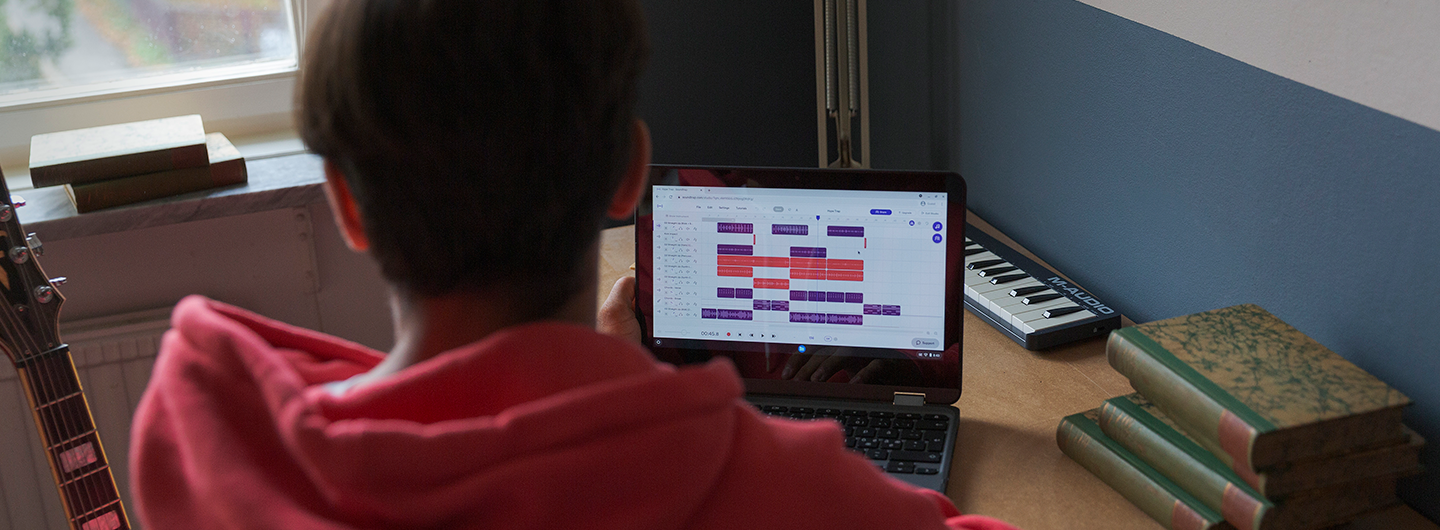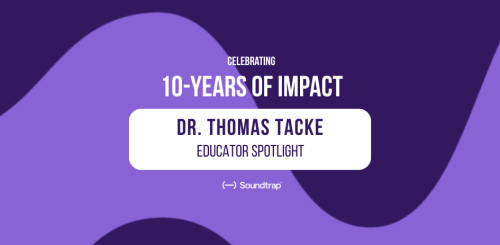
Music Composition 101: Getting Your Students Started
April 27, 2023Learning about music composition benefits all students, even if they’re not in music class. Creating music with friends is a great opportunity for students to develop their creative thinking skills and learn how to work together to solve problems. It also teaches students how to manage complex emotions and stressful situations.
Most music students would like to learn how to create their own musical compositions. However, many students can find this too challenging and give up before they figure out the basics. But making music doesn’t need to be complicated! In fact, it’s easier than ever with the right approach.
If your students are ready to create music, they’ll need to master the basics of music composition first. Today, we’ll go over the benefits of learning about music composition and explore a few fun lesson plans that make it easy for students to create their own musical compositions.
Why Should Students Learn Music Composition?
As educational institutions encourage students to get high scores on standardized tests, they are slowly reducing their budgets for art and music programs. However, schools fail to realize that music education improves reading comprehension, while music training alters the structure of neural networks in the brain to improve student attention spans and decision-making.
5 Benefits of Learning About Music Composition
Students that give up on learning how to compose their own music will miss out on the many benefits that come with creating unique music. Not only does creating music relieve stress, but it also builds confidence, discipline, creativity, and more.
Working together to create music will open a new world of possibilities for your students. If you’re still on the fence about bringing music composition to your classroom, these benefits will surely change your mind!
1. Learning About Music Composition Builds Confidence
Most people think making music is too hard or that learning music composition is simply boring. You can show your class that making music is much easier than they may think — and it can be loads of fun too! This imbues them with the courage to create music, plus apply this confidence to other areas of their lives.
Whether your students are sharing their musical compositions with the class or posting their creations online for the whole world to hear, it takes quite a bit of self-confidence to play their music for others. But when students share their music, it presents a great opportunity for them to develop a level of self-confidence that will serve them for a lifetime.
2. Composing Music Enhances Creativity
There are plenty of research findings to support the assertion that composing music increases creativity and cognitive development in children. For instance, an investigative study at MSU showed that 93% of the students that completed an honors program had musical training.
Since music composition is all about creating unique music, it primes the mind to become creative in all academic subjects. When it comes to learning music composition, the sooner students learn, the better. And the best part is, students don’t need to spend months or years studying music theory to reap the benefits. With modern EdTech tools, your students can apply their knowledge as soon as possible and begin composing music from day one!
3. Learning About Music Composition Teaches Discipline
The most rewarding things in life are worth working for, and learning to create music is one of them! Using knowledge of music composition to create a song from start to finish requires perseverance and commitment. But when your students complete their projects, they’ll realize that consistent work allowed them to achieve their goals.
4. Creating Music Together Encourages Teamwork
It’s important that your students know how to collaborate with others. Fortunately, teaching the class about music composition is a great way to get started! When students work on their musical compositions as a group, they learn more about how each person can use their strengths to enhance the group project. And as students work together on group projects, they’ll also learn life lessons about teamwork and building relationships.
5. Composing Music Provides Stress Relief
The stress of schoolwork, extracurricular activities, and home life can take a toll on your students’ mental health. As students learn about music composition, they’ll develop the skills necessary to express their innermost feelings, which provides much-needed stress relief. And most importantly, your students can use these skills long after their formal education to alleviate stress as they grow into adulthood.
Music Composition 101 with Soundtrap for Education
Ready to introduce music composition in your classroom? We’ve made music creation fun with these engaging lesson plans. Instead of relying on outdated, laborious methods to build songs, use these lesson plans to let your students easily master music compositions by creating, collaborating, and connecting in the Soundtrap studio!
1. Cover a Pop Song
It can be intimidating to write a song from scratch. But when your students can start by observing how music form relates to their favorite popular music compositions, they’ll quickly get excited! Let them further their composition knowledge by creating covers of the pop songs they know and love. With our Become a Pop Star lesson plan, students will learn about tempo, lyrics, recording, and microphone use as a class.
Introduce the class to this fun lesson plan by playing a few songs from this playlist. Encourage your students to get in the groove, dance, and have fun! Let the entire class vote on which song they like the most and then divide the class into three groups.
Each group will be responsible for covering a different part of the song, including the Intro, Verse, and Bridge. The entire class will work on the chorus together.
Before your class gets started, set the song to the right tempo before you import the MP3 file into the Soundtrap studio. Then, record each group one at a time while the other groups practice the lyrics. Once the verses and bridge are complete, get the whole class together to record the chorus!
If your students are super excited about this lesson plan, you can always incorporate extended learning by letting students choose their own pop songs and record them on their own. With this creative knowledge, the possibilities are endless!
2. Learning About Musical Form
Every student learning about music composition will need to develop a firm understanding of musical form. These subjects can get complex, but we’ve simplified these concepts in our Musical Form lesson plan so students of all ages can participate!
Start by introducing the basics of musical form and the meanings of important musical terms, including binary, ternary, and rondo with this video. Give a few examples by starting with binary form songs, and explain how your students can identify section changes. You can make this part fun by letting the whole class participate! Just hold up flashcards with A and B for each section change as the song plays.
Once your students grasp the concept of musical form, let them open up Soundtrap and compose a short musical piece for each form. Then, they can save these projects in a music portfolio that they can build upon throughout the school year!
3. Create a Musical Composition
Hands-on learning is the best way for students to understand music composition, so why not jump right in with our Composition Project? In this lesson plan, your students will compose a piece of music by blending all sorts of sounds together in a digital audio workstation. As students work on their music composition projects, they’ll learn more about how to develop their artistic ideas with their peers.
Get started by dividing the class into groups of three. Each student will play a different role in the musical composition, including production, harmonic elements, and rhythmic elements. You can assign these roles yourself, or let each student choose their role.
Next, each group will find inspiration for their musical composition and discuss how they’ll incorporate their inspiration into their song. Once they have their inspiration, they’ll create a musical masterpiece that’s about three minutes long.
Their final composition should demonstrate how they developed the inspiration into a cohesive song with structure, loops, instrumentation, and sounds. Also, make sure students add automation, effects, and vocals for a polished final project. They’ll soon see that composing music is easier than they might think!
Master Music Composition with Soundtrap for Education
Soundtrap for Education is the ultimate audio production platform for students and teachers to create and edit audio recordings. Pupils and educators can easily tap into their artistic side with this intuitive audio platform, which facilitates a creative learning environment for every subject, regardless of the student’s age or experience level.
With Soundtrap for Education, students and teachers can collaborate with advanced cloud technology at any time or place. In addition, the platform comes equipped with a robust resource portal, with tutorials, an external curriculum, and lesson plans to complete the educational experience. And to ensure privacy, teachers can establish safe and secure student collaboration with invite-only groups in Soundtrap’s versatile digital environment.
If you’re ready to enhance your educational experience with an intuitive cloud-based audio production platform, get started today with Soundtrap for Education! And be sure to share this article with other teachers in your network to help spread the joy of learning through sound.
 EDU Portal
EDU Portal


